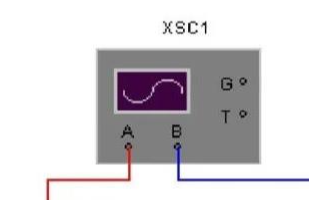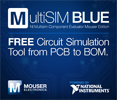NI Multisim:高級的捕捉與設計
Overview
Transforming a design from scribbles on a napkin to an organized and professional schematic is a vital step in any electronics design process, and the need for a productive yet powerful capture tool is critical. As any circuit designer can attest to, time is a valuable commodity, and is better spent on important design work rather than learning the idiosyncrasies of a difficult-to-master capture program.?National Instruments Multisim (Figure 1) is a professional schematic capture and circuit simulation package that has focused on providing powerful design features that integrate seamlessly into the application design flow. This intuitive environment helps any engineer to easily, successfully and quickly complete their designs. In projects of any complexity, Multisim’s advanced capture provides benefits by offering intuitive tools at all levels of schematic capture: from the fundamentals of placement and wiring, to the advanced features of project management and communication.??
Figure 1. Multisim Capture Environment
Intuitive and Efficient Capture
Multisim combines an intuitive simulation environment with advanced capture features to enhance development, reduce repetitive tasks, and become an asset to any circuit designer. The true benefits of these features are easily realized in Multisim, because they are implemented within an easy-to-use environment with intuitive interfaces. In the majority of EDA tools tasks such as component selection, placement, and wiring are time-intensive and laborious. Multisim has been developed to break away from this arduous mold.
Every schematic begins with the selection and placement of components, and as a result an engineer’s initial task is to search their capture tool’s database for specific components. Many traditional EDA tools are lumbered with disorganized databases that are difficult to navigate. In these tools, component selection is?a hurdle in the design process. In Multisim, all 17,000 components in the master database are logically organized into easy-to navigate groups (Figure 2). These groupings reflect the type of device and functionality, so that components such as diodes are in one group, while op-amps populate a separate analog group. This logical organization mirrors the way most manufacturers present their own parts libraries, providing an intuitive interface that an engineer has encountered many times before.
Figure 2. Multisim database organization
With components selected from the database, the engineer is faced with the second fundamental task in capture:?wiring together individual components. Inherently the design process is quite involved as an engineer continuously navigates to the database, searches for and picks a part, and then wires it into the design. In many traditional EDA tools, an engineer will quickly realize that wiring requires them to repeatedly switch between placement and wiring modes for each new component and wire to be placed. Over the course of an entire design, this constant switching can border upon painful for an engineer. In Multisim, this tedium is eliminated by a modeless environment, where the mouse cursor’s proximity to pins and other connectors will automatically allow the drawing of wires (Figure 3). The ability to quickly create connections without constantly switching between drawing modes makes the capture process much more efficient.
Figure 3. Effortless wiring in the Multisim modeless environment
With parts placed and connections created, even a simple design begins to evolve into a schematic of size and complexity. Devices and wires span a sheet, making the search for specific elements somewhat difficult. This is an issue since the nature of the development process is to be in a state of constant change, with elements being moved and edited while a design is improved. The ability to easily manage and access these elements across a vast schematic is extraordinarily important. For a design of any scope, the Multisim spreadsheet view (Figure 4) is a detailed tabular listing of all nets and components that can be sorted by reference designator, schematic sheet and other properties. The engineer benefits from an organized, single interface in which to view and edit the properties of the listed design elements. This spreadsheet view gathers the functionality that can normally only be accessed by selecting the part itself on the schematic. This offers immediate and comprehensive access to all elements of a circuit. From this spreadsheet view, a footprint can be changed, a part replaced and a net renamed, eliminating the trying task of searching across multiple pages and numerous blocks to accomplish the same result.
Figure 4. Replacing a part from the Spreadsheet View
Project-Based Design
As the schematic evolves in size and complexity, the design can naturally become cluttered, unreadable and difficult to understand. Designs of scale can be better managed and organized with a modular approach by splitting the circuit’s functionality into blocks that exist across several schematic files (Figure 5). The project management tools in Multisim provide an effective manner in which to handle and keep track of various functional modules and their respective interconnections within the greater design. Not only does this efficiently organize a design, but it also results in re-usable hierarchical blocks that can be shared among multiple projects and teams of engineers.
Figure 5. Modular design with Hierarchical Blocks in Multisim
When using hierarchical blocks for modular design, the next requirement of the capture tool is to centrally manage all stages of the design, from schematics to datasheets, to proposal and design documents. This entails a project-based approach, and is advantageous to both to small simple designs and more complex and broad-reaching circuits. In the Multisim environment a project can be defined. Through this project all schematics, layout files and documents can be linked together. This organization creates a single project that binds the separate parts of a design into one entity, simplifying the management of all parts of the design process, particularly in team development. When?collaboration extends among cubicles or continents, Multisim provides an organized way to effectively bring a design together.
Design Communication
The collaborative process nurtured by project management creates a real need for effective communication. Engineers may develop individual sections of a schematic, however, it is important that anyone who views the design fully understand each of these modules and the design decisions made. Communication is therefore paramount and schematic features and statistics need to be fully and clearly conveyed. In Multisim, regions of interest and importance can be annotated in a straightforward manner, with comments that exist directly on the schematic.
As the design approaches completion, the group of people with vested interest in the project extends beyond design engineers, so communication must be more structured than inserted comments alone. Others, who review or evaluate a project, require detailed design information. Reporting provides an organized snapshot of a design by communicating what is key in the evaluation of a project plan. For example, a Bill of Materials (Figure 6) can be generated to list all components in the schematic, providing a detailed view of what devices are required to manufacture the design. The benefit of any report in Multisim is that it is populated automatically with a single mouse click enabling effortless communication. Major aspects of the design are covered in these reports, and they can be either printed or exported to applications such as Microsoft Excel for easy sharing.
Figure 6. Effortless generation of Bill of Materials
Conclusion
Multisim has distinguished itself as a capture environment with advanced features that are an asset in function as well as implementation. The sophisticated abilities of the software have been enhanced by intuitive and easy-to-use integration into the development environment, ensuring their respective benefit to the user. Whether a design is simple or complex, Multisim’s functionality can be rapidly adopted to help successfully complete a project. The intuitive capture environment integrates advanced tools such as modeless placement and routing, an easy-to-use interface, advanced project management and essential reporting. Multisim’s focus on advanced tools does not compromise accessibility, and this uniquely ensures successful completion of a project by reducing effort and frustration while increasing the available time for innovation.
 電子發燒友App
電子發燒友App

























評論